12 Best AI Workflow Automation Tools for B2B & SaaS in 2025
In today's fast-paced B2B and SaaS landscapes, efficiency isn't just a goal; it's a survival metric. Repetitive, manual tasks drain valuable hours from your team, create bottlenecks, and introduce costly human errors. From managing lead pipelines to onboarding new clients, these operational drags prevent you from focusing on high-impact activities like strategy, innovation, and customer relationships. The solution lies in intelligent automation.
AI workflow automation tools are no longer a futuristic luxury. They are essential platforms that empower businesses to streamline operations, reduce overhead, and accelerate growth. Before diving into specific platforms, if you need a refresher on the foundational concepts, this comprehensive guide to workflow automation offers an excellent overview of core principles and benefits.
This listicle cuts through the marketing noise to deliver a detailed analysis of the top 12 platforms designed for modern business needs. We move beyond generic feature lists to provide you with:
- Honest assessments of each tool's strengths and limitations.
- Practical use cases for B2B, SaaS, and agency teams.
- In-depth looks at key features, pricing, and implementation.
Each review includes screenshots and direct links, helping you find the right solution to reclaim time, boost productivity, and scale your business effectively.
1. MakeAutomation
MakeAutomation distinguishes itself not as a self-serve platform but as a specialized, done-for-you automation service. It’s an ideal choice for B2B and SaaS businesses that lack the in-house expertise or bandwidth to build complex systems from scratch. Their core offering is creating bespoke automation frameworks, making them a powerful partner for scaling operations without the high overhead of a dedicated hire.
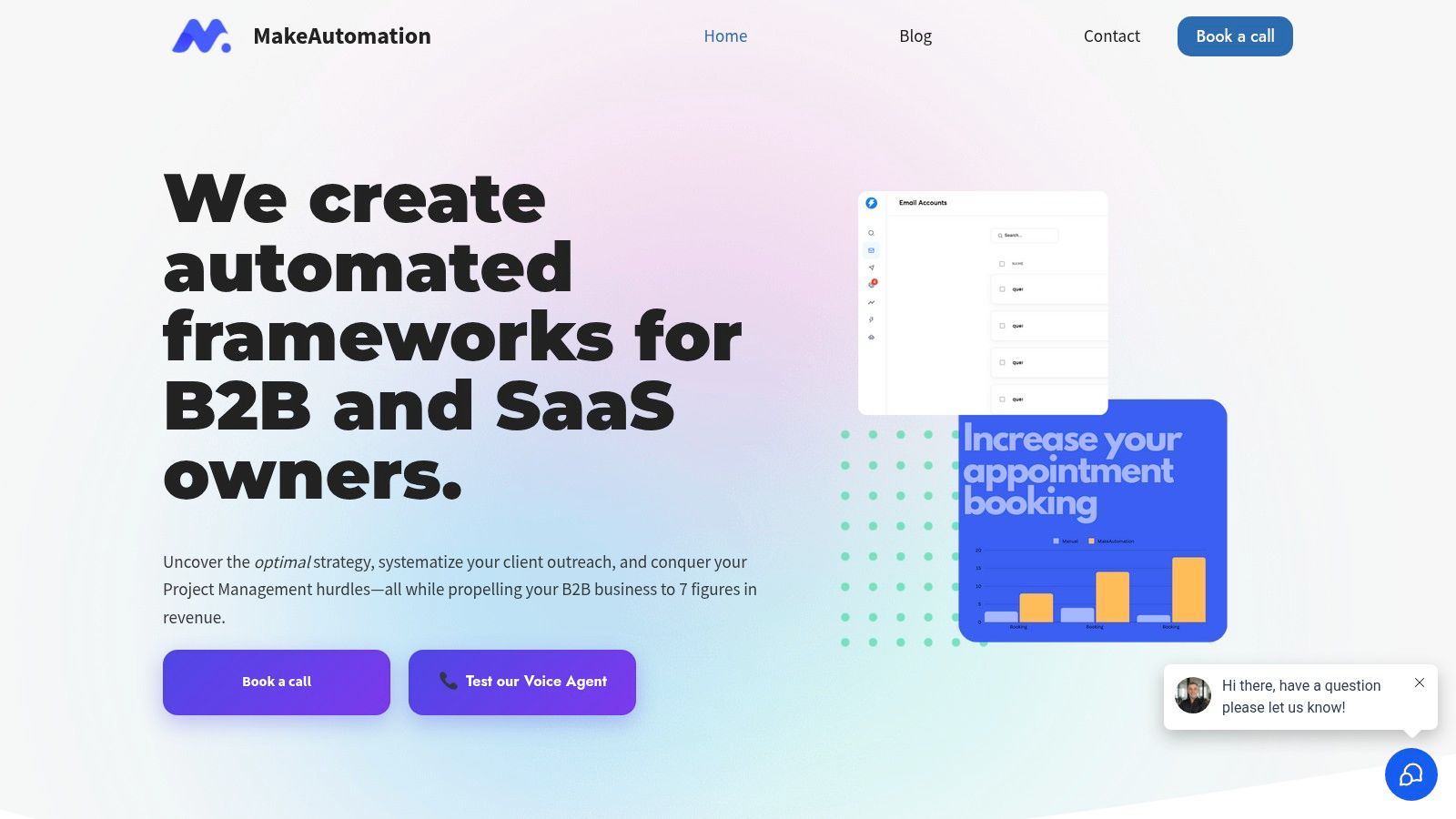
Unlike generic tools, MakeAutomation focuses on high-impact business functions. They deliver custom solutions for lead generation, CRM automation, project management, and even recruitment, all designed to reclaim time and accelerate revenue growth. This tailored approach is one of the most effective ways to implement sophisticated AI workflow automation tools directly into your core processes for maximum ROI.
Key Strengths & Use Cases
A standout feature is the integration of Voice AI Agents for automating both inbound and outbound calls, a capability that sets it apart from many competitors. This allows for truly intelligent, end-to-end operational scaling. Founder Quentin's hands-on involvement and deep expertise are consistently praised by clients, ensuring that complex AI systems are not only built but also clearly documented and understood.
- Best For: Founders, sales leaders, and project managers in growth-stage companies seeking expert-led automation.
- Pricing: Operates on a subscription model, providing ongoing consultation and support at a fraction of the cost of hiring a full-time automation specialist.
- Pro Tip: Come prepared with a clear understanding of your most significant operational bottlenecks. This will enable the MakeAutomation team to design the most impactful and efficient custom workflows for your business needs.
Website: https://makeautomation.co
2. UiPath
UiPath is a heavyweight in the world of Robotic Process Automation (RPA), offering a sophisticated suite of AI workflow automation tools designed for enterprise-level challenges. Where simpler tools connect APIs, UiPath deploys software "robots" that can mimic human actions to interact with legacy systems, virtual desktops, and complex applications that lack robust APIs. This makes it ideal for automating deeply entrenched, high-volume processes in sectors like finance, healthcare, and manufacturing.
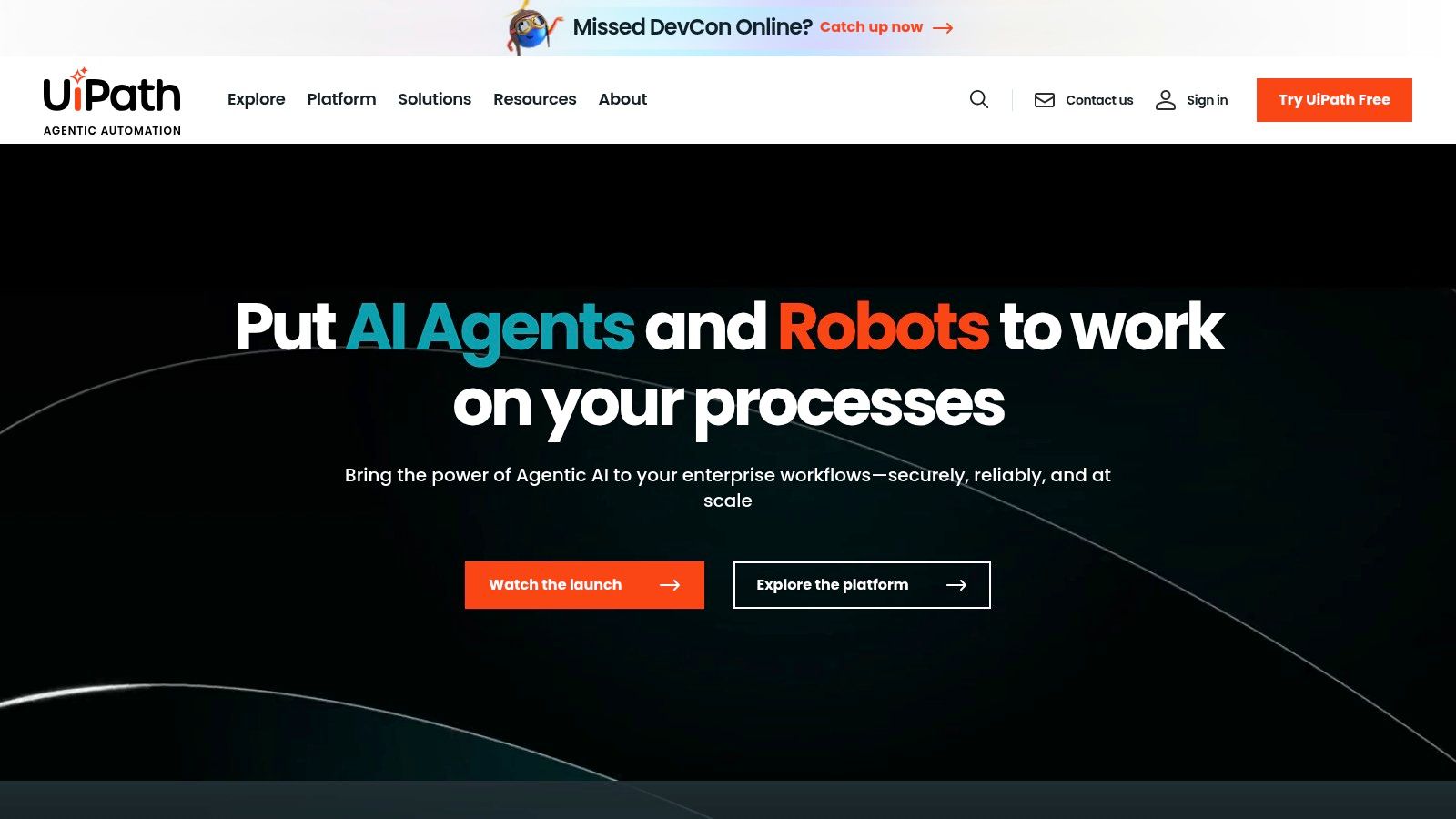
The platform’s strength lies in its end-to-end capabilities, from process discovery and AI-powered analytics to a user-friendly, drag-and-drop workflow designer. For B2B and SaaS teams, this means automating tasks like invoice processing, customer data migration, and complex compliance reporting. The extensive integration library and strong community support provide a solid foundation for building resilient automations.
Key Details & Use Cases
- Best For: Enterprise-level businesses with complex, legacy systems and a need for robust, scalable automation across departments.
- Pricing: Offers a free Community Edition for individuals and small teams. Paid plans (Pro, Enterprise) are custom-quoted and can be a significant investment, reflecting their enterprise focus.
- Pros: Highly versatile and powerful, excellent for tasks beyond simple API integrations, and strong community support.
- Cons: The learning curve is steeper than many no-code platforms, and premium plans are costly for smaller businesses.
- Website: UiPath
UiPath's comprehensive approach makes it a leader for organizations ready to invest in serious digital transformation. Learn more about the core principles of what workflow automation is to see how tools like UiPath fit into a broader strategy.
3. Automation Anywhere
Automation Anywhere is a major competitor in the AI-powered RPA space, offering a cloud-native and web-based platform designed for enterprise-grade automation. Its primary differentiator is its user-friendly interface, which aims to make building complex bots accessible to both business users and developers. This makes it a strong contender for companies looking to democratize automation across various departments without requiring extensive coding knowledge for every task.
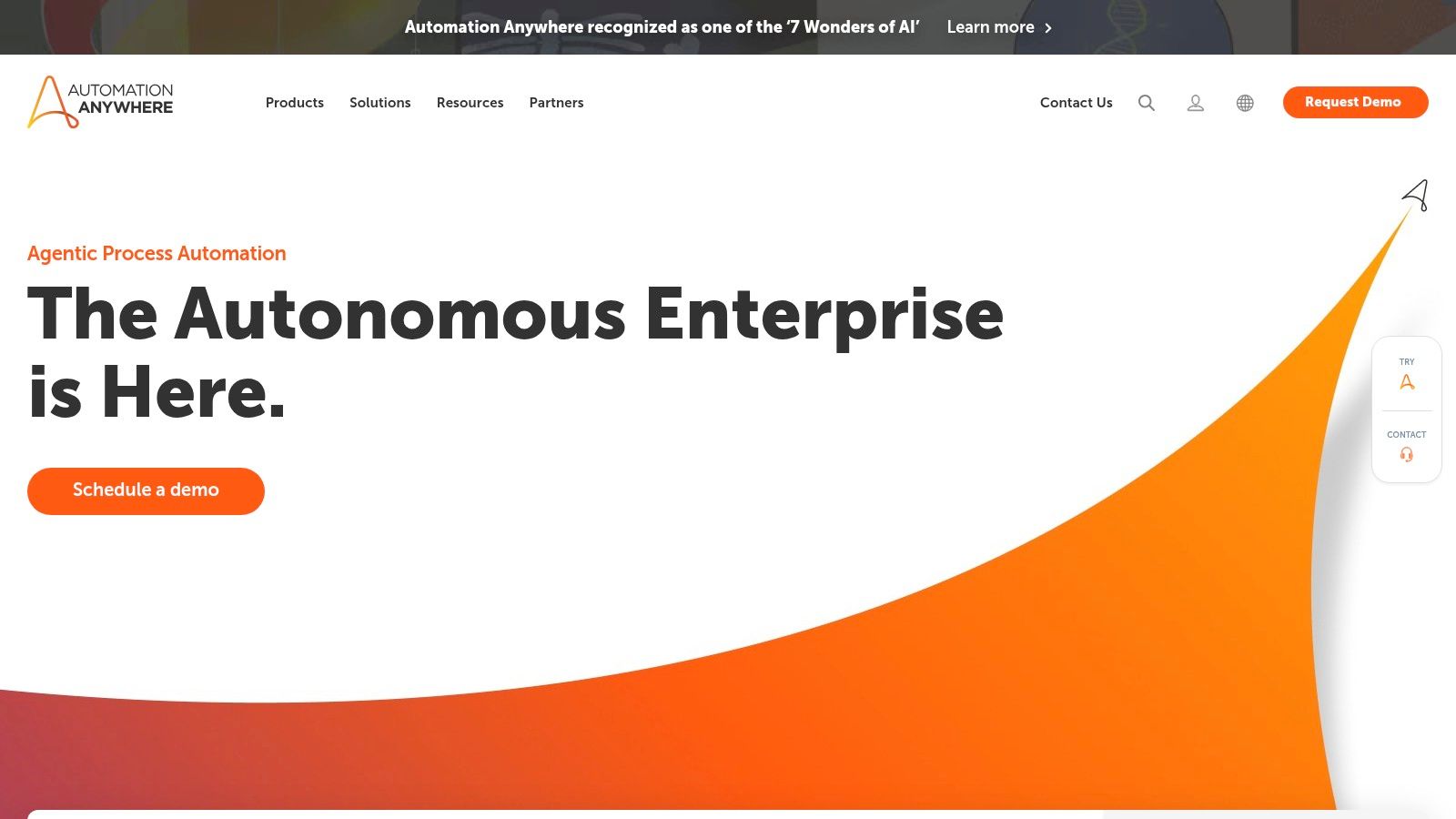
The platform integrates RPA with AI and machine learning, allowing B2B and SaaS teams to automate not just repetitive tasks but also more complex processes that involve decision-making and data analysis. With a large marketplace of pre-built bots for specific industries and functions, businesses can accelerate their automation journey significantly. This focus on accessibility and pre-built solutions makes it one of the more versatile ai workflow automation tools available.
Key Details & Use Cases
- Best For: Medium to large enterprises seeking a scalable, cloud-first RPA platform with a user-friendly interface for both technical and non-technical staff.
- Pricing: A free Community Edition is available. Paid plans are custom-quoted based on the scale of deployment and specific products used.
- Pros: Highly scalable and cloud-native architecture, intuitive interface lowers the barrier to entry, and an extensive marketplace of ready-to-deploy bots.
- Cons: The initial setup can be complex and may require dedicated IT resources, and unlocking advanced AI features often requires additional training.
- Website: Automation Anywhere
Automation Anywhere excels in providing a balanced platform that combines power with usability, making it a strategic choice for businesses aiming to embed intelligent automation deep within their operational fabric.
4. Microsoft Power Automate
Microsoft Power Automate is a powerful, cloud-based service deeply woven into the fabric of the Microsoft ecosystem. It excels at creating automated workflows that connect Microsoft 365, Dynamics 365, Azure, and hundreds of other services. For businesses already invested in Microsoft’s suite, this platform is a natural extension, offering a seamless way to automate processes without stepping outside their existing technology stack. Its combination of API-based flows and Robotic Process Automation (RPA) makes it a versatile player in the AI workflow automation tools landscape.
The platform stands out for its user-friendly, low-code interface which allows business users to build sophisticated automations with relative ease. For B2B teams, this translates to easily automating tasks like email notifications, data synchronization between SharePoint and Excel, or lead processing from Forms into Dynamics 365. The inclusion of AI Builder provides access to models for tasks like form processing, object detection, and text classification directly within workflows.
Key Details & Use Cases
- Best For: Organizations heavily reliant on the Microsoft ecosystem seeking to automate cross-application processes with enterprise-grade security.
- Pricing: Offers a limited free plan within some Microsoft 365 subscriptions. Paid plans start per user, with premium plans required for RPA and advanced AI capabilities, which can become costly.
- Pros: Unmatched integration with Microsoft products, a user-friendly interface, and robust security and compliance features.
- Cons: Less efficient for workflows outside the Microsoft ecosystem and advanced features are locked behind higher-priced tiers.
- Website: Microsoft Power Automate
By leveraging its deep integrations, you can streamline project management using AI automation by connecting tools like Planner, Teams, and SharePoint seamlessly.
5. Zapier
Zapier is often considered the gateway to workflow automation, connecting over 7,000 web applications to let users create automated workflows, or "Zaps," without writing a single line of code. Its distinction lies in its sheer breadth of integrations and user-friendly interface, making it exceptionally accessible. Recently, it has enhanced its platform with AI features, allowing users to build Zaps using natural language and receive AI-powered suggestions, solidifying its position as one of the most versatile ai workflow automation tools available.
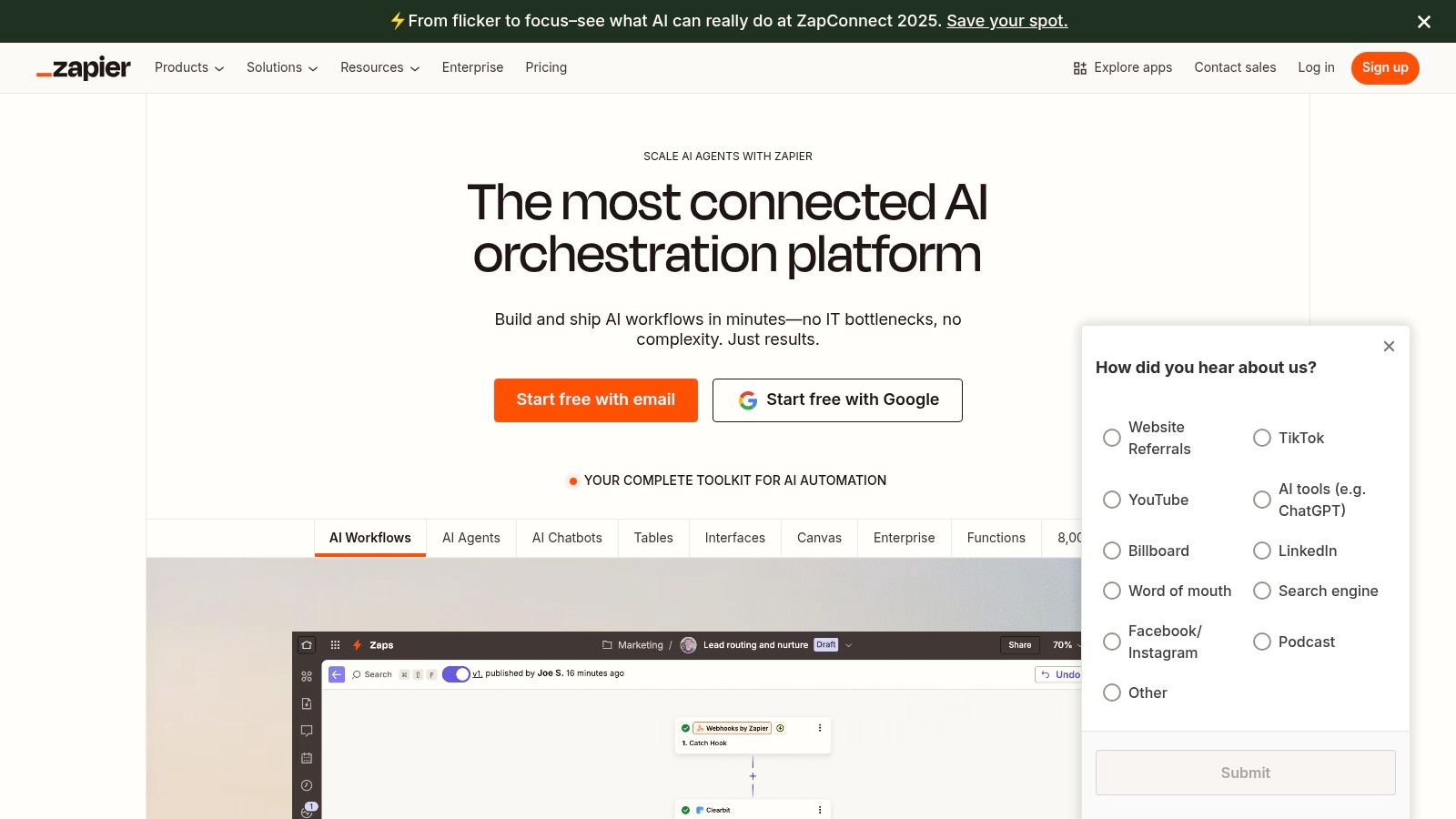
The platform empowers B2B and SaaS teams to automate repetitive tasks across their entire tech stack. For example, a new lead in a CRM can automatically trigger a sequence in an email marketing tool, a notification in Slack, and a task in a project management app. This seamless, multi-step automation is Zapier's core strength, freeing up valuable time for strategic work.
Key Details & Use Cases
- Best For: Small to medium-sized businesses and teams needing to connect a wide variety of cloud-based apps without technical expertise.
- Pricing: A limited free forever plan is available. Paid plans start at the "Starter" tier and increase with more features and a higher number of tasks per month.
- Pros: Massive library of app integrations, incredibly easy to use with a gentle learning curve, and flexible workflow customization.
- Cons: Costs can escalate quickly as task usage grows, and the free tier has significant limitations on multi-step Zaps.
- Website: Zapier
Zapier's simplicity makes it a powerful starting point for any business looking to dip its toes into automation. To get the most out of the platform, you can discover more by unlocking efficiency with Zapier automation and applying advanced techniques to your workflows.
6. Workato
Workato stands as a leader in the enterprise automation space, often recognized as an Integration Platform as a Service (iPaaS). It excels at creating complex, business-critical workflows that connect hundreds of cloud and on-premise applications. Positioned for larger organizations, Workato provides a low-code/no-code environment where both business and IT teams can collaborate on building powerful automations, from HR onboarding sequences to intricate financial reconciliation processes.
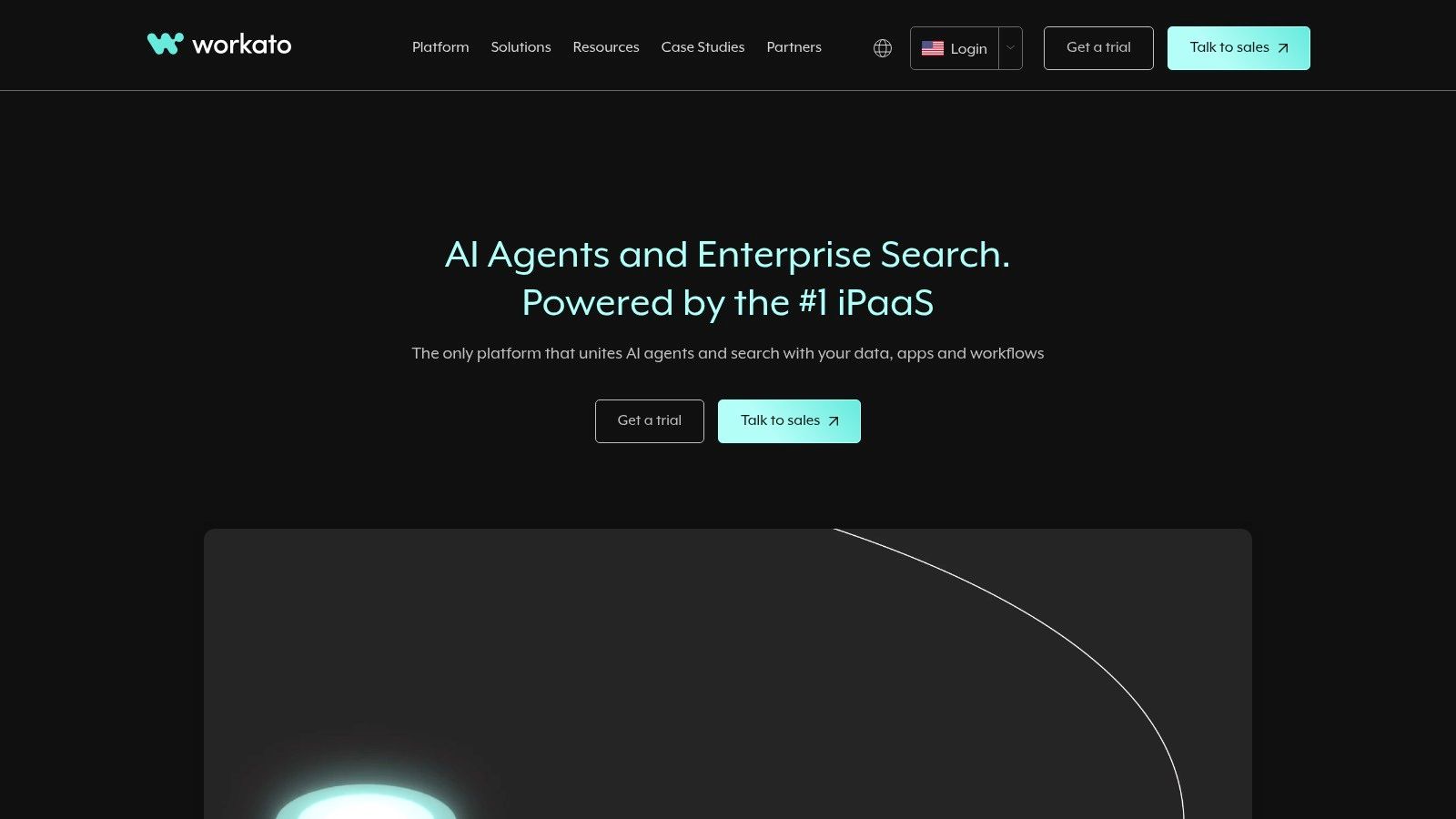
The platform’s "recipes" (its term for automated workflows) are highly capable, handling conditional logic, data mapping, and real-time data syncing with ease. For B2B and SaaS companies, this means seamlessly connecting CRM, ERP, and marketing automation systems to create a single source of truth for customer data. Its AI-powered insights help optimize these workflows over time, making it one of the more sophisticated ai workflow automation tools for businesses focused on scalability and robust governance.
Key Details & Use Cases
- Best For: Enterprise organizations needing a highly scalable and secure platform to automate core business processes across multiple departments.
- Pricing: Pricing is customized based on usage and specific business needs. It is generally geared toward the enterprise market and represents a significant investment.
- Pros: Extremely powerful and scalable, advanced AI and machine learning capabilities for optimizing recipes, and a strong focus on security and governance.
- Cons: The platform can have a steeper learning curve for non-technical users, and its cost is prohibitive for small businesses or startups.
- Website: Workato
7. Blue Prism
Blue Prism is a foundational player in the Robotic Process Automation (RPA) space, providing enterprise-grade, AI-powered automation solutions. It distinguishes itself with a strong focus on security, governance, and scalability, making it a trusted choice for highly regulated industries like banking and insurance. Blue Prism's "digital workforce" is designed to operate within a secure, audited framework, executing complex business rules and interacting with a wide array of applications, from mainframes to modern cloud services.
This platform empowers B2B and SaaS organizations to automate end-to-end processes like financial reconciliation, claims processing, and employee onboarding. Its visual process designer allows for the creation of sophisticated workflows without deep coding knowledge, while its advanced assessment tools help identify the best automation opportunities for maximum ROI. Blue Prism's approach provides a robust framework for building and managing a resilient digital workforce, making it one of the top-tier ai workflow automation tools for large-scale operations.
Key Details & Use Cases
- Best For: Large enterprises in regulated industries needing secure, scalable, and auditable automation with strong governance.
- Pricing: Pricing is customized based on enterprise needs and the number of digital workers deployed. It is a premium solution geared toward significant organizational investment.
- Pros: Highly secure and compliant automation solutions, excellent for large-scale enterprise deployments, and extensive support and training resources.
- Cons: The platform has a steeper learning curve compared to no-code tools and the cost can be prohibitive for small to medium-sized businesses.
- Website: Blue Prism
8. n8n
n8n (pronounced "n-eight-n") stands out in the AI workflow automation tools space with its source-available, self-hostable model. This gives developers and technical teams ultimate control and flexibility, allowing them to build complex, custom automations without the constraints or costs of proprietary platforms. While it offers a no-code, node-based visual editor that is accessible to less technical users, its true power is unlocked when you need to extend its functionality with custom code or host it on your own infrastructure for maximum data privacy and security.
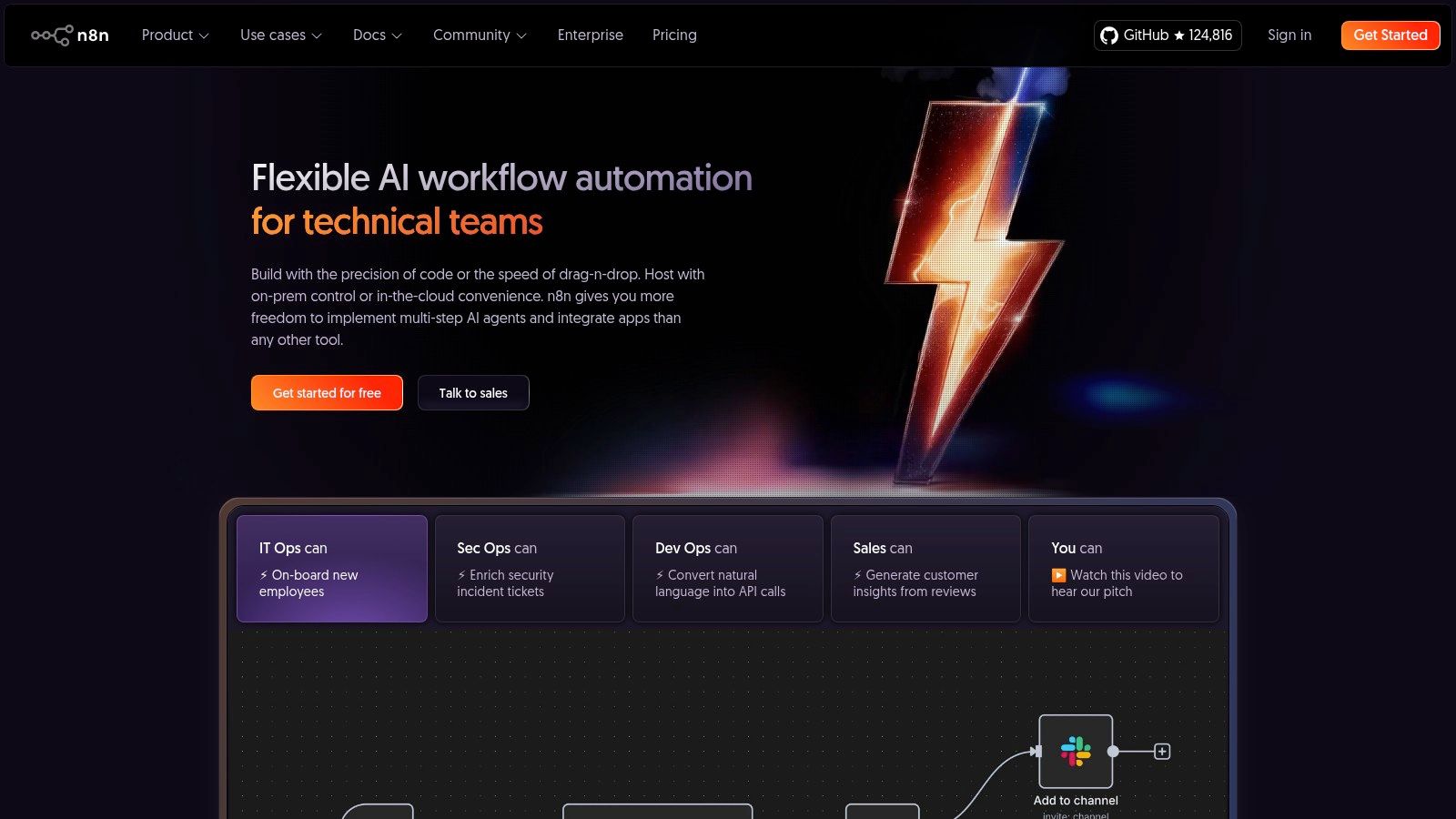
The platform is built around "nodes," where each node represents an app or a function, like reading a database, sending a Slack message, or calling an AI model. For B2B teams, this means connecting disparate tools in unique ways, such as creating a workflow that pulls lead data from a CRM, enriches it via an AI API, and then routes it to the correct sales rep. The active community provides a wealth of shared workflows and support, making it a powerful choice for those willing to get hands-on.
Key Details & Use Cases
- Best For: Technical teams, developers, and businesses that require high levels of customization, data privacy, and the ability to self-host their automation stack.
- Pricing: Free to self-host with community support. Paid cloud plans offer managed hosting, starting with a free "Starter" tier and scaling up with "Pro" and "Enterprise" plans based on workflow executions.
- Pros: Highly flexible and customizable, source-available for transparency, cost-effective for self-hosters, and a strong community.
- Cons: Requires more technical knowledge for setup and complex workflows, and official support is limited to paid cloud tiers.
- Website: n8n
9. Bardeen.ai
Bardeen.ai distinguishes itself by operating directly within your browser as a powerful AI assistant, focusing on automating tasks that happen on the web. Instead of complex, server-based workflows, Bardeen uses "playbooks" to automate actions like scraping data from a website into a Google Sheet, enriching contact information from LinkedIn, or creating meeting summaries. This makes it one of the most accessible AI workflow automation tools for individuals and teams whose work is primarily browser-based.
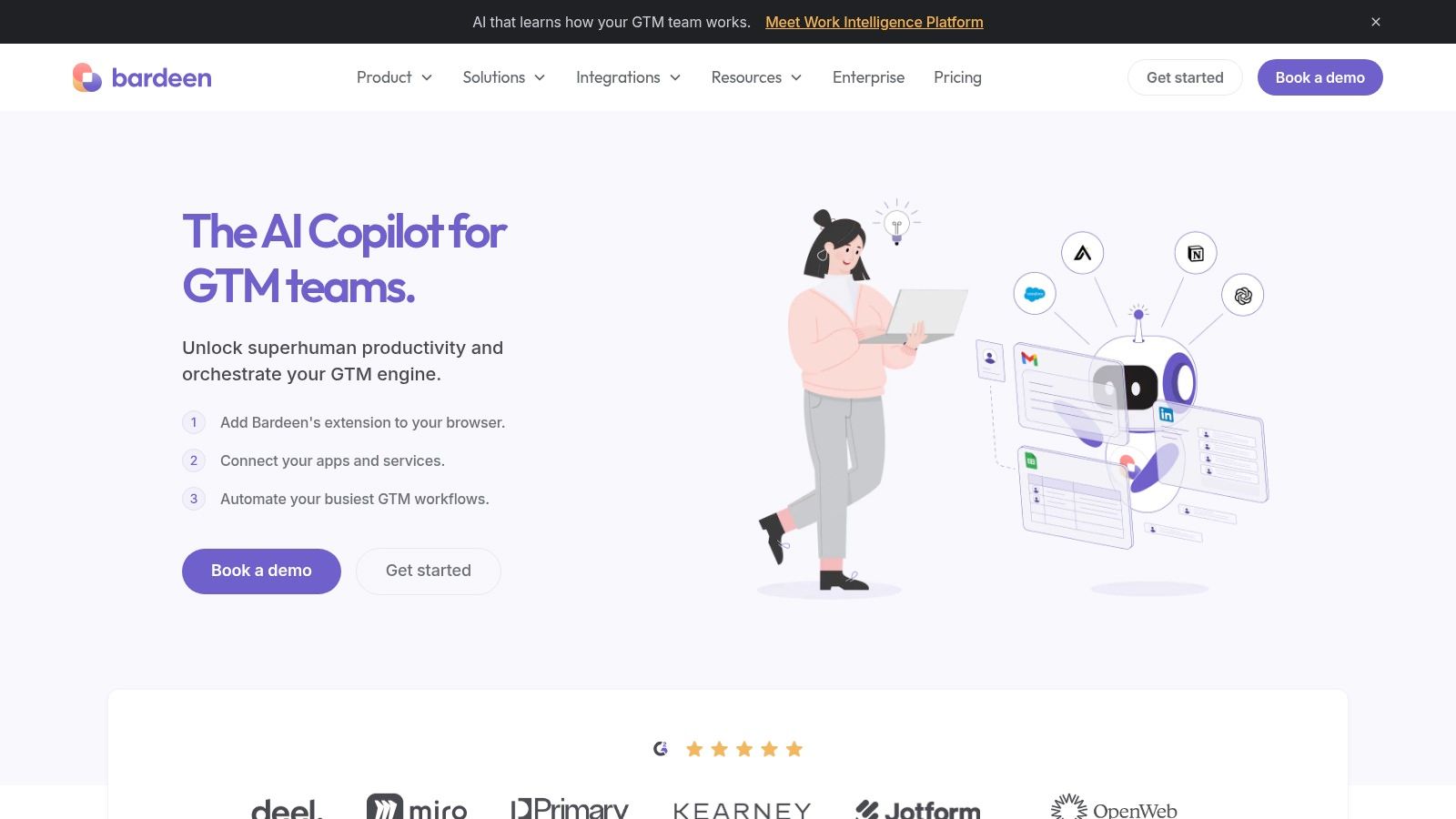
The platform shines for its simplicity and immediate utility. For B2B and SaaS teams, this translates into rapidly automating lead generation research, managing sales pipelines, and streamlining recruitment outreach without ever leaving the web page you're working on. Its AI-powered capabilities help manage and transfer data seamlessly between web apps, turning repetitive manual processes into one-click actions.
Key Details & Use Cases
- Best For: Individuals and teams, especially in sales, marketing, and recruitment, who need to automate browser-based tasks and data transfers quickly.
- Pricing: Offers a generous free plan for individuals. The Professional plan is priced per user, per month, offering more advanced features and higher usage limits.
- Pros: Very user-friendly with a minimal learning curve, excellent for web scraping and browser-based automation, and a strong free offering.
- Cons: Integrations are less extensive than larger platforms, and it is less suited for complex, multi-system automations that occur outside the browser.
- Website: Bardeen.ai
Bardeen.ai is a fantastic entry point for those looking to automate their daily web-based routines without a steep technical barrier.
10. AirOps
AirOps positions itself as an AI application layer, enabling teams to build and deploy custom AI-powered workflows directly on top of their existing data. Instead of offering a generalist automation platform, AirOps focuses on creating high-quality, task-specific AI apps that leverage large language models like GPT-4 and connect seamlessly with SQL databases, Snowflake, and other data warehouses. This makes it one of the more specialized AI workflow automation tools, ideal for data-intensive tasks.

The platform empowers users to chain together complex sequences of prompts and data lookups, allowing for sophisticated applications like personalized content generation, customer support response drafting, or sales outreach personalization at scale. For B2B and SaaS teams, this means moving beyond simple API calls to build intelligent systems that can reason with company-specific data to complete complex tasks, from data analysis to natural language processing.
Key Details & Use Cases
- Best For: Data-savvy teams and developers who need to build custom AI applications and workflows that are deeply integrated with their own data sources.
- Pricing: Offers a free plan with limited credits. Paid plans include a Starter plan at $49/month per user and custom-quoted Business and Enterprise tiers for more advanced needs.
- Pros: Highly flexible and customizable, enables powerful task-specific AI apps, and supports advanced prompt engineering techniques.
- Cons: Has a steeper learning curve than no-code platforms and may require some technical or SQL knowledge for optimal setup.
- Website: AirOps
11. Gumloop
Gumloop is a no-code platform engineered specifically for building and automating complex, AI-powered workflows. Its key differentiator is the deep integration of various AI models directly into its automation fabric, allowing users to chain together sophisticated actions that go beyond simple data passing. Instead of just connecting apps, Gumloop lets you build multi-step AI agents for tasks like personalized outreach, data analysis, and content generation, all within a visual canvas.
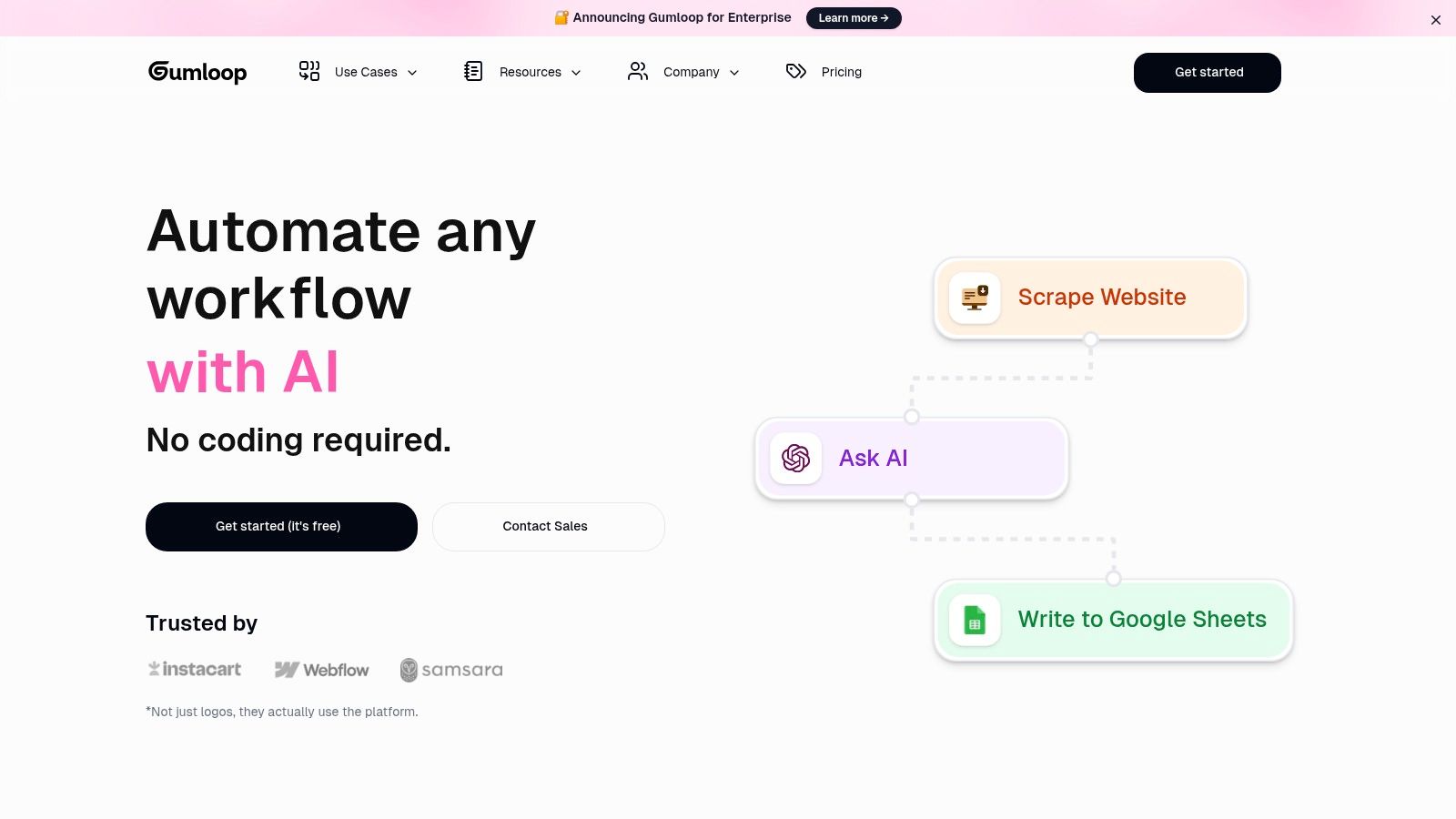
The platform supports multiple AI providers and features an extensive library of pre-built nodes, empowering B2B and SaaS teams to create highly customized solutions. For example, you could build a workflow that scrapes a prospect's website, uses an AI to analyze the content for pain points, and then drafts a personalized email. The ability to run sub-workflows in parallel also makes it one of the more powerful AI workflow automation tools for scalable operations.
Key Details & Use Cases
- Best For: Tech-savvy teams and developers who need to build advanced AI agents and custom automations without extensive coding.
- Pricing: Starts with a paid plan at around $29/month, with higher tiers for more advanced features and usage, positioning it as a premium tool.
- Pros: Powerful AI-first automation capabilities, highly extensible with support for multiple AI models, and a growing library of templates.
- Cons: Has a steeper learning curve compared to simpler tools and a higher starting price point may deter smaller users.
- Website: Gumloop
12. ClickUp
ClickUp positions itself as the "one app to replace them all," and its approach to AI workflow automation reflects this ambitious goal. While primarily a project management powerhouse, its native AI tools and robust automation engine allow teams to streamline processes directly within their workspace. Instead of just connecting external apps, ClickUp uses AI to summarize tasks, generate project updates, write content, and automate status changes based on triggers, making it a central hub for productivity.
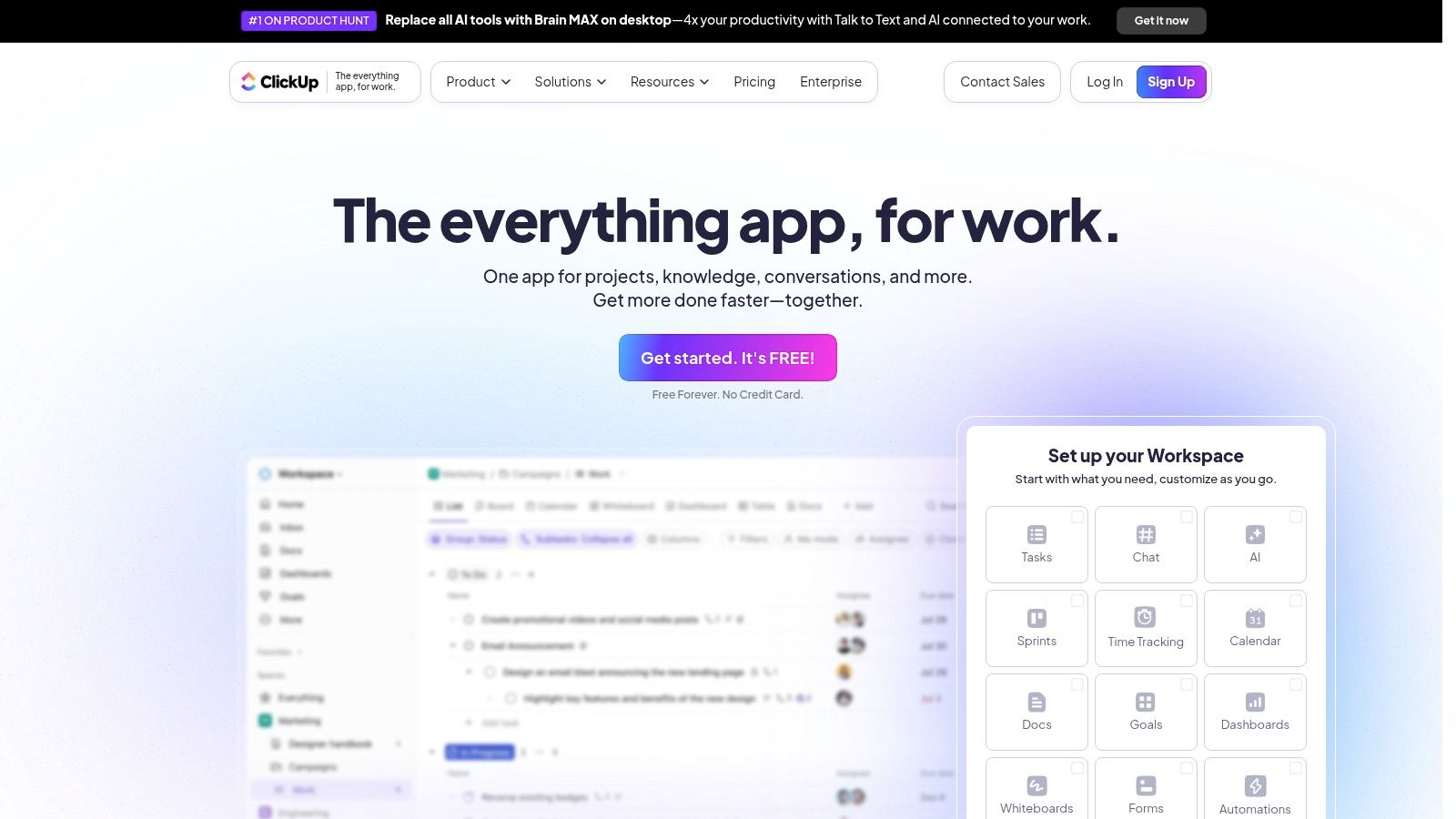
This integrated approach is ideal for B2B and SaaS teams who want to reduce context switching. For example, marketing teams can automate content brief generation, while sales teams can trigger follow-up tasks based on CRM updates. Its strength lies in combining task management with intelligent automation, turning a project plan into a self-managing workflow. ClickUp is one of the more versatile ai workflow automation tools for teams that want AI embedded in their daily operations.
Key Details & Use Cases
- Best For: Teams of all sizes looking for an all-in-one project management and productivity platform with deeply integrated AI features.
- Pricing: Offers a Free Forever plan with limited automations. Paid plans start at $7/user/month (Business) and scale up, with the ClickUp AI add-on available for an additional $5/user/month.
- Pros: Highly flexible and customizable, user-friendly interface, and combines project management with powerful automations in one place.
- Cons: The sheer number of features can be overwhelming during initial setup, and accessing all advanced automation and AI features requires higher-tier plans.
- Website: ClickUp
ClickUp’s all-in-one model makes it a strong contender for organizations aiming to consolidate their tech stack while enhancing productivity through AI.
AI Workflow Automation Tools Comparison
| Solution | Core Features | User Experience & Quality | Value Proposition | Target Audience | Price Points |
|---|---|---|---|---|---|
| MakeAutomation | Custom AI automation frameworks (lead gen, CRM, recruitment), Voice AI agents | High engagement (97.8% open, 7.35% reply), 22% team efficiency boost | Affordable subscription, end-to-end support, proven ROI | Founders, sales leaders, PMs, recruiters | Subscription-based, cost-efficient |
| UiPath | RPA with AI & machine learning, workflow designer, wide integrations | Versatile but steeper learning curve | Free & premium plans, strong community | Enterprises across industries | Free & premium tiers, can be costly |
| Automation Anywhere | RPA + machine learning, cloud options, sector-specific bots | User-friendly, scalable with analytics | Scalable with extensive monitoring | Businesses of all sizes | Paid plans, IT setup needed |
| Microsoft Power Automate | Microsoft 365 integration, AI automation, pre-built templates | User-friendly, enterprise-grade security | Best for Microsoft users | Microsoft ecosystem users | Paid, higher for advanced features |
| Zapier | 7,000+ app integrations, no-code AI workflows | Very user-friendly, no coding needed | Flexible, customizable | Small to medium businesses | Free & paid tiers, limited free features |
| Workato | Enterprise integrations, real-time sync, AI insights | Highly scalable but complex | Advanced AI, enterprise focus | Large enterprises | Premium pricing, enterprise focus |
| Blue Prism | AI RPA, workflow mgmt, cloud integration | Secure & robust, steep learning curve | Large-scale automation | Large organizations | Premium pricing |
| n8n | Open-source, custom no-code workflows | Flexible, active community | Highly customizable, free core | Tech-savvy users, startups | Open-source, self-host or cloud |
| Bardeen.ai | AI assistant, data & workflow automation | User-friendly, AI-driven task management | Improves productivity | Task managers, professionals | Paid plans, limited free features |
| AirOps | Custom AI apps, NLP & ML, data integration | Flexible but technical setup | Advanced AI applications | AI developers, tech teams | Paid, higher for SMBs |
| Gumloop | AI actions, multi-model AI support, parallel workflows | Powerful but steep learning curve | AI-focused scalability | Advanced automation users | Premium pricing |
| ClickUp | AI project mgmt, automations, collaboration | Flexible, user-friendly | All-in-one management | Teams of all sizes | Free & paid, advanced features paid |
Choosing the Right Automation Partner for Your Growth
Navigating the landscape of AI workflow automation tools can feel overwhelming, but this extensive listicle should provide a clear map. We've journeyed from accessible integrators like Zapier and n8n, perfect for connecting your existing SaaS stack, to powerful enterprise-grade platforms like UiPath and Automation Anywhere, designed for large-scale robotic process automation (RPA). We also explored modern, AI-native tools like AirOps and Gumloop that are pushing the boundaries of what's possible.
The central takeaway is that there is no single "best" tool; there is only the best tool for your specific context, team size, and strategic goals. Your choice represents a significant strategic decision, one that will directly influence your operational efficiency, scalability, and competitive edge for years to come.
How to Make Your Final Decision
As you move from evaluation to implementation, focus on a few critical factors to guide your selection. Don't let an impressive feature list distract you from what your business truly needs to thrive.
Key considerations include:
- Scalability: Will this platform grow with you? A tool like Bardeen.ai is excellent for individual productivity, but will it support a sales team of 50? Conversely, an enterprise solution like Blue Prism may be overkill for a startup.
- Technical Requirements: Assess the skills on your team. No-code platforms like MakeAutomation and Zapier empower non-technical users, while developer-centric tools like n8n or UiPath require specialized expertise to unlock their full potential.
- Depth vs. Breadth: Do you need a tool that does one thing exceptionally well, or one that connects everything? Workato excels at broad, enterprise-wide integrations, whereas a specialized tool might offer deeper functionality for a specific department, like sales or HR.
- Total Cost of Ownership (TCO): Look beyond the monthly subscription fee. Factor in implementation time, training costs, and the potential need for dedicated staff or external consultants to manage the system effectively.
To further aid in your decision-making process and deepen your understanding of the landscape, consider consulting a comprehensive AI workflow automation guide that can offer additional frameworks and strategic insights.
Ultimately, selecting the right platform is about finding a partner, not just a product. The most effective AI workflow automation tools are those that seamlessly integrate into your operations, empower your team, and deliver a clear, measurable return on investment. Choose wisely, implement thoughtfully, and you’ll unlock a new level of productivity and growth.
Ready to move beyond DIY tools and implement a custom automation strategy built for your business? The experts at MakeAutomation specialize in designing, building, and managing bespoke AI workflows that drive real results. Explore MakeAutomation to see how a dedicated automation partner can accelerate your growth.







